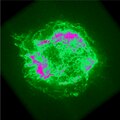File:Cassiopeia A- Elemental Image Of Exploded Star (2000-cas a062700 - casa2).jpg
From Wikimedia Commons, the free media repository
Jump to navigation
Jump to search
Cassiopeia_A-_Elemental_Image_Of_Exploded_Star_(2000-cas_a062700_-_casa2).jpg (394 × 392 pixels, file size: 47 KB, MIME type: image/jpeg)
File information
Structured data
Captions
Captions
A new 14 hour Chandra observation of the supernova remnant Cassiopeia A has given the best map yet of heavy elements ejected in a supernova explosion.
Summary
[edit]| DescriptionCassiopeia A- Elemental Image Of Exploded Star (2000-cas a062700 - casa2).jpg |
English: A new 14 hour Chandra observation of the supernova remnant Cassiopeia A has given the best map yet of heavy elements ejected in a supernova explosion. Upper left: Broadband X-ray image of Cassiopeia A (Cas A) Upper right: Image made by X rays from silicon ions. Lower left: Image made by X rays from calcium ions. Lower right: Image made by X rays from iron ions. All images are 8.5 arc minutes on a side (corresponding to 28.2 light years at a distance of 11,000 light years). These images are designed to show the distribution of some of the elements ejected in the explosion that produced Cas A. The elements are part of a gas that has a temperature of about 50 million degrees Celsius. The colors represent intensity of X rays, with yellow the most intense, then red, purple, and green. The broadband image, which shows all the X rays detected from Cas A, is more symmetric than the others. This could be due to the presence of X rays from synchrotron radiation by extremely high-energy particles spiraling in the magnetic field of the remnant, or to shock waves traveling through material puffed off thousands of years before the supernova. The silicon image shows a bright, broad jet breaking out of the upper left side of the remnant, and faint streamers in an opposite direction. This jet could be due to an asymmetry in the explosion. The calcium image is similar to the silicon image, but less bright and clumpier. The iron image shows significant differences from other images. Since iron is the heaviest element shown, these maps support the suggestion that the layers of the star were overturned either before or during the explosion. |
| Date | 27 June 2000 (upload date) |
| Source | Cassiopeia A: Elemental Image Of Exploded Star |
| Author | NASA/GSFC/U.Hwang et al. |
| Other versions |
|
| Also Known As InfoField | Cas A |
| Category InfoField | Supernovas & Supernova Remnants |
| Color Code InfoField | Colors represent different energy bands |
| Constellation InfoField | Cassiopeia |
| Coordinates (J2000) InfoField | RA 23h 23m 26.7s |
| Distance Estimate InfoField | 11,000 light years |
| Observation Date(s) InfoField | January 30 - 31, 2000 |
| Observation ID(s) InfoField | 114 |
| Observation Time InfoField | 14 hours |
| Scale InfoField | Image is 8.5 arcmin across. |
| Instruments InfoField | ACIS |
 |
This media is a product of the Chandra X-ray Observatory Credit and attribution belongs to the Chandra X-ray Center, NASA/SAO/Penn State University/MIT |
Licensing
[edit]| Public domainPublic domainfalsefalse |
| This file is in the public domain in the United States because it was solely created by NASA. NASA copyright policy states that "NASA material is not protected by copyright unless noted". (See Template:PD-USGov, NASA copyright policy page or JPL Image Use Policy.) |  | |
 |
Warnings:
|
File history
Click on a date/time to view the file as it appeared at that time.
| Date/Time | Thumbnail | Dimensions | User | Comment | |
|---|---|---|---|---|---|
| current | 16:07, 15 June 2024 |  | 394 × 392 (47 KB) | OptimusPrimeBot (talk | contribs) | #Spacemedia - Upload of https://chandra.si.edu/photo/2000/cas_a062700/casa2.jpg via Commons:Spacemedia |
You cannot overwrite this file.
File usage on Commons
The following 10 pages use this file:
- File:Cassiopeia A- Elemental Image Of Exploded Star (2000-cas a062700).pdf
- File:Cassiopeia A- Elemental Image Of Exploded Star (2000-cas a062700 - casa1).jpg
- File:Cassiopeia A- Elemental Image Of Exploded Star (2000-cas a062700 - casa3).jpg
- File:Cassiopeia A- Elemental Image Of Exploded Star (2000-cas a062700 - casa300 1).tiff
- File:Cassiopeia A- Elemental Image Of Exploded Star (2000-cas a062700 - casa300 2).tiff
- File:Cassiopeia A- Elemental Image Of Exploded Star (2000-cas a062700 - casa300 3).tiff
- File:Cassiopeia A- Elemental Image Of Exploded Star (2000-cas a062700 - casa300 4).tiff
- File:Cassiopeia A- Elemental Image Of Exploded Star (2000-cas a062700 - casa4).jpg
- File:Cassiopeia A- Elemental Image Of Exploded Star (2000-cas a062700 - casa comp).jpg
- File:Cassiopeia A- Elemental Image Of Exploded Star (2000-cas a062700 - casa comp).tiff
Metadata
This file contains additional information such as Exif metadata which may have been added by the digital camera, scanner, or software program used to create or digitize it. If the file has been modified from its original state, some details such as the timestamp may not fully reflect those of the original file. The timestamp is only as accurate as the clock in the camera, and it may be completely wrong.
| Image title |
|
|---|---|
| Author | Chandra X-ray Observatory Center |
| Copyright holder | |
| Source | Chandra X-ray Observatory |
| Credit/Provider | NASA/GSFC/U.Hwang et al. |
| Headline | Elements mapped in Cas A SNR. |
| Short title |
|
| Usage terms | |
| Date and time of data generation | 27 June 2000 |
| Orientation | Normal |
| Exif version | 2.21 |
| Color space | Uncalibrated |
| Date metadata was last modified | 09:45, 20 October 2011 |
| Date and time of digitizing | 12:34, 12 October 2007 |
| Unique ID of original document | F805DCFB8EFC7DAFC107032DEF2F7BCF |
| Keywords | Cassiopeia A |
| Contact information | cxcpub@cfa.harvard.edu
60 Garden St. Cambridge, MA, 02138 USA |
| IIM version | 4 |










